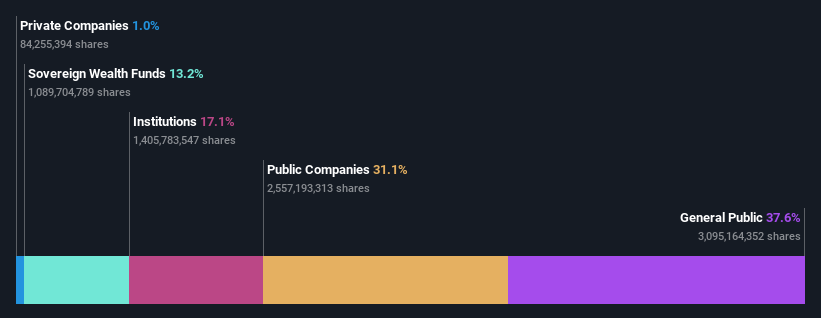Founder Securities Co., Ltd. (SHSE:601901) Stock Most Popular Amongst Individual Investors Who Own 38%, While Public Companies Hold 31%
Founder Securities Co., Ltd. (SHSE:601901) Stock Most Popular Amongst Individual Investors Who Own 38%, While Public Companies Hold 31%
Key Insights
关键见解
- Significant control over Founder Securities by individual investors implies that the general public has more power to influence management and governance-related decisions
- 52% of the business is held by the top 4 shareholders
- 17% of Founder Securities is held by Institutions
- 个人投资者对方正证券的严格控制意味着公众拥有更大的影响管理和治理相关决策的权力
- 52% 的业务由前四名股东持有
- 17% 的方正证券由机构持有
If you want to know who really controls Founder Securities Co., Ltd. (SHSE:601901), then you'll have to look at the makeup of its share registry. With 38% stake, individual investors possess the maximum shares in the company. That is, the group stands to benefit the most if the stock rises (or lose the most if there is a downturn).
如果你想知道谁真正控制着方正证券有限公司(SHSE: 601901),那么你必须看看其股票登记处的构成。个人投资者拥有38%的股份,拥有公司的最大股份。也就是说,如果股票上涨,该集团将受益最大(如果出现低迷,则损失最大)。
Public companies, on the other hand, account for 31% of the company's stockholders.
另一方面,上市公司占公司股东的31%。
Let's delve deeper into each type of owner of Founder Securities, beginning with the chart below.
让我们从下图开始,深入研究方正证券的每种类型的所有者。

What Does The Institutional Ownership Tell Us About Founder Securities?
关于方正证券,机构所有权告诉我们什么?
Many institutions measure their performance against an index that approximates the local market. So they usually pay more attention to companies that are included in major indices.
许多机构根据近似于当地市场的指数来衡量自己的表现。因此,他们通常会更多地关注主要指数中包含的公司。
Founder Securities already has institutions on the share registry. Indeed, they own a respectable stake in the company. This can indicate that the company has a certain degree of credibility in the investment community. However, it is best to be wary of relying on the supposed validation that comes with institutional investors. They too, get it wrong sometimes. When multiple institutions own a stock, there's always a risk that they are in a 'crowded trade'. When such a trade goes wrong, multiple parties may compete to sell stock fast. This risk is higher in a company without a history of growth. You can see Founder Securities' historic earnings and revenue below, but keep in mind there's always more to the story.
方正证券已经在股票登记处设立了机构。事实上,他们拥有该公司可观的股份。这可能表明该公司在投资界具有一定程度的信誉。但是,最好谨慎行事,不要依赖机构投资者所谓的验证。他们也是,有时候会弄错。当多家机构拥有一只股票时,总是存在处于 “拥挤交易” 的风险。当这样的交易出错时,多方可能会竞相快速出售股票。对于没有增长历史的公司,这种风险更高。你可以在下面看到方正证券的历史收益和收入,但请记住,故事总是有更多内容。

Founder Securities is not owned by hedge funds. Our data shows that Ping An Insurance (Group) Company of China, Ltd. is the largest shareholder with 29% of shares outstanding. With 13% and 7.5% of the shares outstanding respectively, National Council for Social Security Fund and China Cinda Asset Management Co., Ltd., Asset Management Arm are the second and third largest shareholders.
方正证券不归对冲基金所有。我们的数据显示,中国平安保险(集团)股份有限公司是最大股东,已发行股份为29%。全国社保基金委员会和中国信达资产管理有限公司资产管理部门分别占已发行股份的13%和7.5%,是第二和第三大股东。
Our research also brought to light the fact that roughly 52% of the company is controlled by the top 4 shareholders suggesting that these owners wield significant influence on the business.
我们的研究还揭示了这样一个事实,即该公司约有52%的股份由前四名股东控制,这表明这些所有者对业务具有重大影响。
Researching institutional ownership is a good way to gauge and filter a stock's expected performance. The same can be achieved by studying analyst sentiments. Quite a few analysts cover the stock, so you could look into forecast growth quite easily.
研究机构所有权是衡量和筛选股票预期表现的好方法。通过研究分析师的情绪也可以达到同样的目的。有不少分析师报道了该股,因此你可以很容易地研究预测的增长。
Insider Ownership Of Founder Securities
方正证券的内部所有权
While the precise definition of an insider can be subjective, almost everyone considers board members to be insiders. Company management run the business, but the CEO will answer to the board, even if he or she is a member of it.
尽管内部人士的确切定义可能是主观的,但几乎每个人都认为董事会成员是内部人士。公司管理层经营业务,但首席执行官将对董事会负责,即使他或她是董事会成员。
I generally consider insider ownership to be a good thing. However, on some occasions it makes it more difficult for other shareholders to hold the board accountable for decisions.
我通常认为内部所有权是一件好事。但是,在某些情况下,这使其他股东更难追究董事会对决策的责任。
We note our data does not show any board members holding shares, personally. It is unusual not to have at least some personal holdings by board members, so our data might be flawed. A good next step would be to check how much the CEO is paid.
我们注意到,我们的数据并未显示任何董事会成员个人持有股份。董事会成员不持有至少部分个人持股的情况很少见,因此我们的数据可能存在缺陷。一个不错的下一步是检查首席执行官的薪水是多少。
General Public Ownership
一般公有制
With a 38% ownership, the general public, mostly comprising of individual investors, have some degree of sway over Founder Securities. While this group can't necessarily call the shots, it can certainly have a real influence on how the company is run.
拥有38%的所有权的公众(主要由个人投资者组成)对方正证券有一定程度的影响力。尽管这个群体不一定能做主,但它肯定会对公司的运作方式产生真正的影响。
Public Company Ownership
上市公司所有权
Public companies currently own 31% of Founder Securities stock. It's hard to say for sure but this suggests they have entwined business interests. This might be a strategic stake, so it's worth watching this space for changes in ownership.
上市公司目前拥有方正证券31%的股份。很难肯定地说,但这表明它们将商业利益交织在一起。这可能是一个战略利害关系,因此值得关注这个领域的所有权变动。
Next Steps:
后续步骤:
While it is well worth considering the different groups that own a company, there are other factors that are even more important.
虽然值得考虑拥有公司的不同群体,但还有其他更为重要的因素。
I like to dive deeper into how a company has performed in the past. You can access this interactive graph of past earnings, revenue and cash flow, for free.
我喜欢更深入地了解一家公司过去的表现。您可以免费访问这张过去的收益、收入和现金流的交互式图表。
If you would prefer discover what analysts are predicting in terms of future growth, do not miss this free report on analyst forecasts.
如果你想了解分析师对未来增长的预测,千万不要错过这份关于分析师预测的免费报告。
NB: Figures in this article are calculated using data from the last twelve months, which refer to the 12-month period ending on the last date of the month the financial statement is dated. This may not be consistent with full year annual report figures.
注意:本文中的数字是使用过去十二个月的数据计算得出的,这些数据是指截至财务报表日期当月最后一天的12个月期间。这可能与全年年度报告数据不一致。
Have feedback on this article? Concerned about the content? Get in touch with us directly. Alternatively, email editorial-team (at) simplywallst.com.
This article by Simply Wall St is general in nature. We provide commentary based on historical data and analyst forecasts only using an unbiased methodology and our articles are not intended to be financial advice. It does not constitute a recommendation to buy or sell any stock, and does not take account of your objectives, or your financial situation. We aim to bring you long-term focused analysis driven by fundamental data. Note that our analysis may not factor in the latest price-sensitive company announcements or qualitative material. Simply Wall St has no position in any stocks mentioned.
对这篇文章有反馈吗?担心内容吗?直接联系我们。或者,发送电子邮件给编辑组(网址为)simplywallst.com。
Simply Wall St 的这篇文章本质上是笼统的。我们仅使用公正的方法提供基于历史数据和分析师预测的评论,我们的文章并非旨在提供财务建议。它不构成买入或卖出任何股票的建议,也没有考虑到您的目标或财务状况。我们的目标是为您提供由基本数据驱动的长期重点分析。请注意,我们的分析可能不会考虑最新的价格敏感型公司公告或定性材料。华尔街只是没有持有上述任何股票的头寸。

 Many institutions measure their performance against an index that approximates the local market. So they usually pay more attention to companies that are included in major indices.
Many institutions measure their performance against an index that approximates the local market. So they usually pay more attention to companies that are included in major indices.